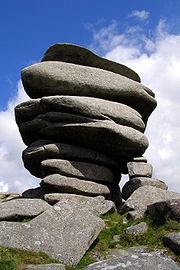
Cheesewring
Encyclopedia

Cornwall
Cornwall is a unitary authority and ceremonial county of England, within the United Kingdom. It is bordered to the north and west by the Celtic Sea, to the south by the English Channel, and to the east by the county of Devon, over the River Tamar. Cornwall has a population of , and covers an area of...
, United Kingdom
United Kingdom
The United Kingdom of Great Britain and Northern IrelandIn the United Kingdom and Dependencies, other languages have been officially recognised as legitimate autochthonous languages under the European Charter for Regional or Minority Languages...
, situated on the eastern flank of Bodmin Moor
Bodmin Moor
Bodmin Moor is a granite moorland in northeastern Cornwall, England, United Kingdom. It is in size, and originally dates from the Carboniferous period of geological history....
on Stowes Hill in the parish of Linkinhorne
Linkinhorne
Linkinhorne is a civil parish and village in southeast Cornwall, United Kingdom. The village itself is situated at and is approximately four miles northwest of Callington and seven miles south of Launceston.-History and geography:As well as Linkinhorne itself, other settlements in the parish...
approximately four miles (6 km) north of Liskeard
Liskeard
Liskeard is an ancient stannary and market town and civil parish in south east Cornwall, England, United Kingdom.Liskeard is situated approximately 20 miles west of Plymouth, west of the River Tamar and the border with Devon, and 12 miles east of Bodmin...
. It is a natural geological formation, a rock
Rock (geology)
In geology, rock or stone is a naturally occurring solid aggregate of minerals and/or mineraloids.The Earth's outer solid layer, the lithosphere, is made of rock. In general rocks are of three types, namely, igneous, sedimentary, and metamorphic...
outcrop of granite slabs formed by weathering
Weathering
Weathering is the breaking down of rocks, soils and minerals as well as artificial materials through contact with the Earth's atmosphere, biota and waters...
. The name derives from the resemblance of the piled slabs to a "cheesewring", a press-like device that was once used to make cheese
Cheese
Cheese is a generic term for a diverse group of milk-based food products. Cheese is produced throughout the world in wide-ranging flavors, textures, and forms....
.

Wilkie Collins
William Wilkie Collins was an English novelist, playwright, and author of short stories. He was very popular during the Victorian era and wrote 30 novels, more than 60 short stories, 14 plays, and over 100 non-fiction pieces...
described the Cheesewring in 1861 in his book Rambles Beyond Railways:
Located adjacent to the Cheesewring Quarry and surrounded by other granite formations, this landmark was threatened with destruction in the late nineteenth century by the proximity of blasting operations, but was saved as a result of local activism.
Legend

Legend
A legend is a narrative of human actions that are perceived both by teller and listeners to take place within human history and to possess certain qualities that give the tale verisimilitude...
says that the Cheesewring is the result of a contest between a man and a giant. When Christianity
Christianity
Christianity is a monotheistic religion based on the life and teachings of Jesus as presented in canonical gospels and other New Testament writings...
had just been introduced to the British Islands, the giant
Giant (mythology)
The mythology and legends of many different cultures include monsters of human appearance but prodigious size and strength. "Giant" is the English word commonly used for such beings, derived from one of the most famed examples: the gigantes of Greek mythology.In various Indo-European mythologies,...
s who lived at the top of the mountains were not happy about it. The Saints had invaded their land and were declaring their wells as sacred. One of the larger giants, Uther, was given the task of ridding their land of the Saints. He confronted the frail St Tue, who proposed a rock throwing contest. If Uther won, the Saints would leave Cornwall. If St. Tue won, then the giants would convert to Christianity. Uther took his turn first and easily threw a small rock to the top of nearby Stowe's Hill. St Tue prayed for assistance, and picking up a huge slab found it was very light. One after the other, they threw their rocks, stacking them up in perfect piles. When the score was twelve stones each, Uther threw a thirteenth stone, but it rolled down the hill. St Tue picked up this fallen stone, and as he lifted it, an angel
Angel
Angels are mythical beings often depicted as messengers of God in the Hebrew and Christian Bibles along with the Quran. The English word angel is derived from the Greek ἄγγελος, a translation of in the Hebrew Bible ; a similar term, ملائكة , is used in the Qur'an...
appeared to carry it to the top of the pile of rocks. Seeing this, Uther conceded, and most of the giants decided to follow Christianity after that.
Notable residents
- Daniel Gumb (d. 1776), stonemason, lived in a cottage nearby; several gravestones in LinkinhorneLinkinhorneLinkinhorne is a civil parish and village in southeast Cornwall, United Kingdom. The village itself is situated at and is approximately four miles northwest of Callington and seven miles south of Launceston.-History and geography:As well as Linkinhorne itself, other settlements in the parish...
churchyard were carved by him.

